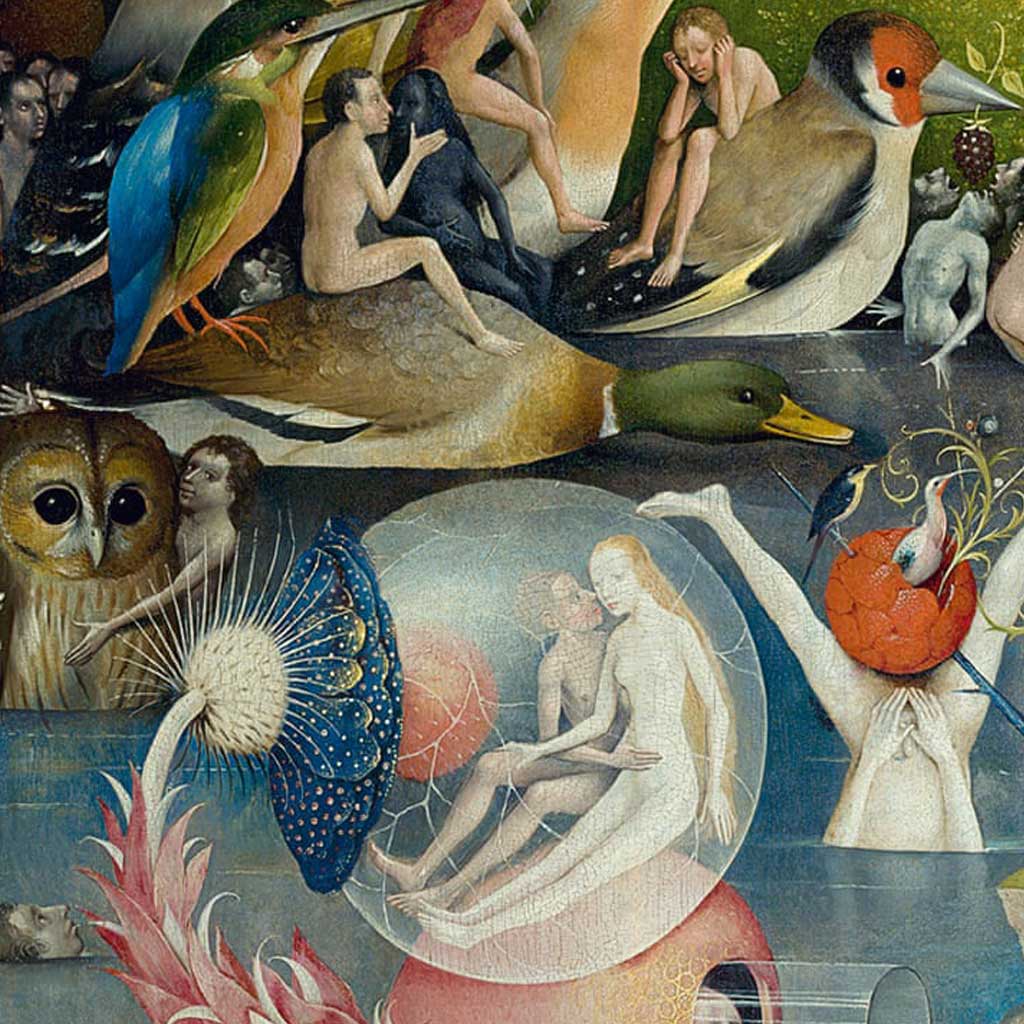Zvara
About music, dance, Zagori Races
and cosmic religion of Greece
OCTOBER 24, 2022 | TSEPELOVO, ZAGORI | 20 MIN

N 39°54'14.7"
E 20°49'13.5"
In the heart of the Pindos Mountains, in the small village of Tsepelovo, every year in July, Zagori Mountain Running competitions are organized. There are four distances to choose from, but the start of each of them is somewhat similar: a crowd of runners, an unusual atmosphere of excitement, a customary countdown and… music played from the speakers: a sharp guitar screeching at the beginning, then a wind instrument singing, powerful guitar and bass riffs combined with overwhelming drum beats, finally vocals.
Blade Runner
on Peloponnese

That day I wanted to cross the mountains.
Not high. Separating the central part of the Peloponnese from the eastern coast. It was in the second week of my journey around the great, mulberry-leaf shaped, Greek peninsula. I had over 1000 km in my legs, countless bays and sea views under my eyelids, the memory of a few Venetian forts and many old towns, located on such steep slopes that some houses grow on the roofs of others. I was constantly reliving the endless serpentine roads and all the shades of sunrises and sunsets that I saw every day. I thought that little could surprise me anymore.
READ MORE
Zvara - song of rebellion
I heard all these sounds for the first time in July 2019 and I immediately felt that it was my music. Classic guitar rock derived in a straight line from the music of Jimi Hendrix and the Led Zeppelin band, at the same time deeply immersed in the Greek tradition. However, Zagori as a region, and the Zagori Mountain Running competition in particular, has so much to offer and evoke so many emotions that right after I ran my 80 km, I forgot about the music from the start a bit, or it is better to say that it lasted in my consciousness in some sleep, waiting for its time.
Finally, I found out that the song accompanying all starts is called Zvara, it is performed by the Villagers of Ioannina City (VIC) band and it is a kind of anthem of this biggest competition in Greece. For a moment it even seemed to me that since the band comes from Ioannina, a town on the border of Zagori, there is something about mountains at the beginning, choosing this song for the competition anthem is kind of a coincidence. Local event to be exact. However, the longer I listen to the VIC, the more closely I follow the lyrics, the more I am convinced that there is no accident at all. The work of Villagers is as if created to describe all struggles, especially running, and most interestingly, some aspects of Greek culture reflect perfectly in their work. In addition, I have a growing impression that running in the mountains and Villagers’ music create an amazing combination of meaningful interrelationships, allowing better understanding of both phenomena. So let’s take a closer look at it.

Secret Life of Cicada
In Litochoro and elsewhere

It was in the middle of hot summer, the peak of the holiday season. I stood in front of the Archaeological Museum of Heraklion in Crete, among the crowd of tourists. I was delighted by amazing sun of July, the lush nature on the square around and the aesthetic madness of the interior of King Minos’s palace that was about to follow soon.
READ MORE
Villagers of Ioannina City - hippie band
The song “Zvara” appeared for the first time on the second, small (EP) album of Villagers of Ioannina City, released in November 2014 by Mantra Records. In addition to the title number, this album contains only one track entitled Karakolia. Both are sung in Greek (a large part of the VIC repertoire is performed in English) and both perfectly define the band’s style, described by critics as psychedelic, stoner and folk rock. Sharp, “metal” sound, elaborate songs, often with long improvisations, use of folk instruments and musical structures from the Epirus region in western Greece.
Regardless of these formal definitions, it seems very accurate to say that Villagers of Ionnina City is a hippie band. Many elements in their music point to this golden age of rock music, and Zvara piece is a good example of this. The first element is rebellion, and this is already at the level of language, and more precisely in its form. Many of the band’s Greek texts are far from literally correct, they contain many slang words or derived from a local dialect or both. In terms of meaning, Zvara is a total rebellion with a bit of utopia, but at the same time a call to action: “go through the mountains, cities and islands, gather everyone and burn down everything old and bad, so that a beautiful flower will grow in this place” (this is a loose travesty of the text, by no means a translation). However, what best defines VIC as a rebel band which goes beyond the templates is the music itself. The metal – at first glance – sound is broken by sophisticated harmonic parades, extensive improvisations and the use of melodic wind instruments. The most important of them is the clarinet, but tuned according to the eastern scales, so its sound often resembles a soprano saxophone. The team also uses a kind of shepherd’s flute from the Epirus region called kaval and the local version of bagpipes. It is the clarinet that plays at the beginning of Zvara and in many other pieces it performs the most characteristic improvisations. The schematic drawing of this instrument is also used in many of the ensemble’s graphics, constituting a kind of hallmark.
The above-mentioned soprano saxophone is obviously associated with jazz and it is not only about its sound, but more about the type of expression and the intensity of the emotions evoked. In the musical layer, Zvara is primarily elation, euphoria and ecstasy. I do not know if Konstantis Pistiolis who plays the clarinet in Villagers is listening to John Coltrane, but the spirit of this great artist is certainly floating over VIC’s music.
Vikos Gorge, middle part of Zagori Marathon course, view from Beloi Place
Olympus
Mythical Trail
Celebrating the Heat
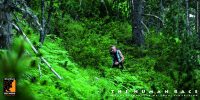
Olympus Mythical Trail is considered the most difficult mountain race in Greece. The route leads around the entire massif, partly along old, forgotten paths, brought back to life by the organizers.
READ MORE
Tsepelovo and Zagori Marathon
Similar elation and euphoria accompanied me at the start of Zagori Marathon this year. Tsepelovo – the place of start and finish – is a village made of gray stone. There are stone houses, stone roofs and even stone roads and of course… stone bridges. The stone is the hallmark of Zagori. Just like the mountains (still green in July), which in the higher parts are built of white stone and often form vertical walls. The landscape is therefore somewhat reminiscent of the Italian Dolomites. Tsepelovo is a tourist village but largely abandoned. Beautifully renovated and attractive guesthouses and small hotels are adjacent to decaying old buildings, which are more and more effectively absorbed by the plant jungle. In the deserted gardens there are still fruit trees, overripe cherries that no one picks up anymore, were just turned into dry seeds with a thin layer of skin, but the small yellow-purple plums were perfectly ripe. Tsepelowo is an abandoned village, so everything seems a bit exaggerated there. Accommodation places specially prepared for runners are located next to an old, abandoned school. Its building is so huge, scattered on different levels, with a spacious hall and long, labyrinthine corridors that it is hard to imagine how noisy this place once must have been. Quiet and sleepy every day, it turns into a bustling sports center for a few days of competition. Traditional scenery, as if frozen in time, and against it a colorful festival of mountain runs. It’s hard not to feel the excitement in a place like this.
The run starts with the main street of the village, dozens of tables in taverns and cafes in the main square under plane trees, and then an absurdly steep uphill. Only two kilometers and the descent begins. Easy and fast. Everyone still has a lot of power, so the pace is increasing. After another three kilometers we run into the first village on the route. Kapesowo – it seems even more deserted and as stone as Tsepelowo. Behind it, the descent becomes even faster, the soft ground encourages you to accelerate, the more that one of the greatest attractions of the route appears in front of your eyes – the mighty, wide and very deep Vikos Gorge. Its vertical walls are said to be 1,300 meters high in places. The route runs partly along gorge bottom, i.e. a river that is dry at this time, but mostly along a soft path full of bends, which winds slightly above. The most important thing, however, is that we are generally moving down the ravine, so the speed increases again. In this episode, I was running with two friends, changing leads every now and then, and you know that nothing evokes greater euphoria than such together run. Zvara was in my head all the time, and I believed that we would run like this through mountains and villages without end.

Phaistos Disk
The messenger of the forgotten world

Phaistos Disk is round in shape, approx. 16 cm in diameter and 1.5 to 2.1 cm thick. It is made of clay with spirally arranged signs on both sides. There are exactly 241 of them, including 45 unique ones.
READ MORE
Hair and Age of Aquarius
It’s hard to write about the hippie movement not to mention the famous film by Milosz Forman “Hair” from 1979, especially its amazing beginning. A farewell scene before the bus leaves in some American provinces, a few postcard pictures of the United States, and we’re in New York’s Central Park. Colorful costumes, a perfectly arranged dance sequence and, of course, music. The world spins, the camera goes along with it, and the main character is amazed that such a world can even exist. The song that drives the scene is called Aquarius and explores one of the most popular themes of the hippie movement and many millenarian movements in general. Here comes the Age of Aquarius (or it is already), the time is changing, there will be peace, understanding and love among people in the world; what is bad will pass. The lexical message of this work is not much richer than the discussion presented above. Even the famous beginning of “When the Moon is in the Seventh House and Jupiter aligns with the Mars”, although it sounds like a precise definition, does not mean anything in the astronomical or even astrological sense, it is just a mere poet’s license of the author of the text, simulating some esoteric knowledge. In the overall meaning of Forman’s film, this conventionality of Aquarius’s text does not interfere in any way, it is intended only as an introduction to the hippie theme, especially since much more is happening in the musical and dance layer.

Villagers of Ioannina City also explore the Aquarius theme, but at a much deeper level. They recorded the entire concept album called Age of Aquarius, where all songs with the title theme are somehow related, and the Aguarius theme itself receives perhaps the most extensive context in rock music and a philosophical and cosmological interpretation. This interpretation strongly defines the VIC as a hippie band on the one hand, but at the same time it is deeply rooted in Greek culture.
scientific basics
But what exactly is the Age of Aquarius?
The basics are as scientific as possible. It turns out that the Earth’s axis of rotation shows some movement disorders. To be precise, it is subject to the phenomenon of slow precession, that is, it rotates around a certain point in space, drawing a circle in the sky (exactly like a twisted children’s toy spinning top or a metal cone in the movie “Inception”, moments before the fall). The period of one full turnover is about 26 thousand years. The point of the vernal equinox (Aries point), i.e. the intersection of the ecliptic with the celestial equator, moves at the same pace, parading against the background of the twelve constellations corresponding to the twelve signs of the zodiac. And since the full turnover takes 26 thousand years, we have 12 constellation – zodiac signs, in each Aries point is about 2160 years. And these are the eras in the history of mankind, each corresponds to a single sign and lasts about 2,160 years – there is no science anymore in it, it’s pure astrology! Lest it be too simple … All these numbers are not coincidental with the term “about”. The precession of the Earth’s axis of rotation is due to the interaction of the Moon, the Sun and other planets; and these interactions reinforce or cancel each other out a bit, so it is impossible to calculate them precisely. The constellations are not actual collections of stars linked by gravitational interactions, but rather random collections of glowing objects in the sky as seen from the perspective of the Little Blue Planet. The constellations are of various sizes and have no “boundaries” – or it is not known where these boundaries run (they have been defined somewhat differently recently). Therefore, it is not obvious that each epoch must last the same time, when it begins and when it ends. However, there is a fairly consistent belief among astrologers that we live somewhere at the turn of the Age of Pisces and the Age of Aquarius. A fairly consistent belief means that some astrological specialists hold that we have been living in the Age of Aquarius since year 1413, and others that we will cross this magical line in 3597! Approx. however, most agree that it was in the 20th century or it will be in the 21st century.
Group of interacting galaxies called Arp 273. HabbleTelescope, Dec. 17, 2010. Photo: NASA/ESA
Seal Of Pylos
Forgotten Masterpiece

It is May 2015. The Archaeological site of Nestor’s Palace in the southwestern Peloponnese, 15 km from the modern town of Pylos on the shores of the Gulf of Navarino
READ MORE
VIC mythical world
So we have the Age of Aquarius! What do the works of Villagers of Ioannina City say about it?
Even though VIC is a heavy rock band, their music is not lacking in illustration. The beginning of the first track on the Age of Aquarius album is the low bass of keyboards, the murmur of flowing water and the sounds of thunder. These voices of nature are quiet, they cannot be properly recreated at concerts, but they are there, building the atmosphere and introducing the first two elements that are extremely important in this context: water and fire. Next comes the “new age”, “the first ray of the sun”, “signs in the sky”, “the fullness of time”, “the start of a new life” and … a flood. The Villagers build their world of imagination from the basic cosmic elements: water, fire, sun, sky, rain … It looks a bit like creating the mythical world, or maybe recreating it today on records or at concerts. It is also no coincidence that there is a flood; since we have Aquarius… In many myths everything that is new is born of water.
Most interestingly, even the personification of Aquarius appears in this mythical world of the VIC. Aquarius is a person, a kind of demiurge or time traveler who is reborn from the water and rain at dawn and comes to change the world:
I’m coming out of river
Breathing out, I’m finally reborn
Rain is falling to the shore
Dawn is coming, the night is almost gone
His arrival is a kind of spectacle, written for various songs from the album “Age of Aquarius” and different persons. The staging is almost operatic. A forest nymph appears who leads our hero to the mountains and shows the ancient (we are in Greece) temple with his name and a call to change the world, bring back light, let us return to Mother Earth and bring back the sun. Because everything is ruled by the cycles of time. Scenography and the intensity of experiences are getting more and more dense. There are collisions of stars, planetary conjunctions, cosmic thunders and, above all, dance.
The structure of the Villagers album, as well as the structure of individual songs, is not rather rational prose, it is impressionistic poetry, full of ambiguous images, repeating motifs and scenes viewed as if from various distances, both narrative, telling a story, or played before our eyes.

fire and dancing in the night
One of the many culminations is the song “Dance of Night”. The image of a crazy, cosmic dance on the night before the arrival of Aquarius or the beginning of the Age of Aquarius, which is the same in the logic of the story. At the concerts at the beginning of this song, the musicians make sounds resembling the howling of wolves, wild syllables of a non-existent language, and only then you hear the first sharp chords of the guitar and bass guitar. The “chorus” also appears very quickly, but in a purely instrumental version, as if a leitmotif overwhelming the wall of sound. The most important thing, however, is the pulse. All the music of the Villagers pulsates in virtually every track, but in Dance of Night this pulse is especially felt. As if focusing and dispersing musical energy. We have no doubts that the great spectacle begins. When the percussion comes on this pulse is even more obvious, it manifests itself as a dance beat as the number is in the form of a traditional Greek dance. The main shaman and vocalist, Aleks Karametis, introduces us to the details of the mystery by singing the text, and Konstantis Pistiolis plays endless improvisations on the bagpipes. Finally, there is a call:
Set the pyre
Lift your spirit higher
Dance through the fire
Go! Go! Go!
Dancing around
There is, of course, fire, breaking the limits of the mind, a sacred circle, and the renewal of nature. The most amazing, however, is the cosmic nature of this dance. It turns out that the expression “All together” means here that angels, spirits and animals dance together with people. No wonder then that at the very end there is a repeated call “Open your eyes, Open your eyes,” – after all, the world has completely changed, and we have become one with the whole universe.

dance according Gerardus van der Leeuw
A surprising similarity to the picture presented above can be found in the considerations on dance by Gerardus van der Leeuw, contained in the famous essay “Do they dance in heaven?” The Dutch religious scholar treated “dance as an increase in the intensity of life achieved thanks to the power of the movement.” The cosmic character of the dance is even more evident with Van der Leeuw than with the Villagers, as he has the following inspired passage:
“The movement keeps getting bigger and bigger and penetrates everything until the stars, clouds and flowers start to dance in a single, world-wide procession. (...) The rhythm is literally captivating and communicates to all who come under its influence; the dance is epidemic. In this way, movement finally becomes all-movement: everything rolls and turns, bounces and jumps to the rhythm of the universe. All movement in nature is rhythmically ordered, and therefore the root cause of dance is identical to that of the cosmos ”.
Villagers of Ioannina City in concert. Photo: Zissis Tsoumbos (with modifications)
Crete
South End Gallery
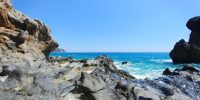
All the photos below were taken on the E4 path on the south coast of Crete. This trail leads almost all the time by the sea, although not always by the very shore. On November 1-5, 2021, I ran the entire route from Chora Sfakion to Elafonisi Beach and back. Total is about 170 km.
READ MORE
running, dancing and Theseus in Delos
I would never have understood the importance of dance so well in the VIC’s world of imagination and in Greek culture if it were not for my personal experience. In Greece, dancing and sports are two sides of the same coin. Dances are held after the Amorgos Trail Event, before Zagori Running, the Hercules Mountain Marathon and many other competitions, especially in the islands. My Greek runner friend was able to dance for half the night after finishing (with the best result among women) the Amorgos competition and for many hours just before the start of Zagori 44 km.
It should be remembered that it is not about dancing in pairs all the time, but a group dance in a circle that can be attended by 100 or more people, and when there is no room in the main square of the village, the circle turns into a spiral, twisted many times. Everything spins to the rhythm of trance music, the songs last a dozen or so minutes, and the emotions are no less than at VIC concerts.
And it is hardly surprising since Plato wrote:
“The dance, of all the arts, is the one that most influences the soul. Dancing is divine in its nature and is the gift of the gods.”
This primal circle and spiral dance is called geranos in Greece, it is a kind of snake dance, even though the Greek word “geranos” means crane. We also know a beautiful myth about its origin. Hereus is Theseus, after defeating Minotaur, he comes with Ariadne and the freed young Athenians to the island of Delos, and there they all dance geranos together for the first time, revealing the new dance to people. The circular and spiral movements are supposed to imitate the movements in the Minos labyrinth in Crete. Thus, the dance would have its origins in the Minoan culture, although one of the theories suggests that it was the dance that was more primal and that it gave rise to the idea of the labyrinth.

dancing of The Holy Trinity
To add the broadest possible context for a dance, it is worth mentioning that the Greek language has the term perichoresis (περιχώρησις – dance in a circle, from περι – around and χωρέω – to go forward), which in Christian theology describes the mutual relations between the persons … of the Holy Trinity. This expression appeared already in the fourth century, i.e. in the period of the formation of the Trinitarian dogma, and was to facilitate the understanding of complex theological and philosophical problems by referring to the close and known sphere of human activity, pointing to the interpenetration of divine persons, love, wholeness and perfection. .
This dance aspect of the Holy Trinity in the Eastern tradition is even visible in iconographic performances, including the famous icon of Andrei Rublev Troy, where the three angels symbolizing divine hypostases are inscribed in a circle and, according to many commentators, remain in a dance relationship.

uphill to Astraka Refuge
I was approaching the village of Megalo Papingo on the 22nd kilometer of the route and my pace slowed down sharply. The downhill run had already ended some time ago, the largest ascent to the Astraka shelter at an altitude of 1900 m was beginning on the route. I was running alone. In a strange twist of fate, my running companions from the first part of the route twisted their ankles and withdrew from the race. Nevertheless, Papingo – in its two versions, Megalo and Micro – still made an electrifying impression. This is probably the most popular village in Zagori, well-kept and full of life, where the rate of abandonment is noticeably lower, but like everywhere in Zagori – the kingdom of gray stone. The only obstacle for the runner are the stone streets, which every half a meter have a transverse row of protruding stones, so you have to raise your legs a bit higher (I understand that this solution was supposed to reduce the possibility of slippage of donkeys and mules – once the main users of these arteries). The ascent is long and arduous. It takes the last of the strength, especially from the competitors who overdid the earlier runoff. The competitors of the longer distance Zagori TeRA 80 km, who run on the same route, but in the opposite direction, are a diversion.
Mega Lakkos, end section, Zagori Mountain Running 2022.
I don’t know why I had any deep conviction that the ascent would end after the Astraka Hut. And it’s actually over, but… only for a moment. The short run down was terribly difficult technically, or maybe that’s what I thought, at least I slowed down noticeably and the girls started to overtake me. We were crossing the Tymfi massif with a kind of alpine valley with peaks exceeding 2400 m on both sides. It was green. Extremely heavy rainfall this year kept the mountains still full of life, and the stones generously distributed along the path were hidden in the grass. On the other hand, the peaks of the Gamila, Astraka and Karteros peaks were traditionally white and, as usual, resembled the Italian Dolomites (in fact, they are partly built of dolomite rocks). I was running slightly uphill all the time, soon over the beautiful Mega Lakkos – a side branch of the Vikos Gorge – climbing higher and higher its steep slopes.

Geranos dance. Illustration from: Richard Thomson - The Dance; Historic Illustrations of Dancing From 3300 B. C. to 1911 A. D.
My Life in Litochoro
and why I am staying here

Litochoro is attached to the edge of the cliff. The Enipeas Gorge, which is cutting the Olympus massif in half, falls almost vertically next to the last houses in the city. It is true that the buildings with taverns are even at the bottom of the gorge, but no one lives there permanently.
READ MORE
dance focuses energy
The phrase “I was ranning” is probably not entirely precise. I rather moved or climbed mountains in a style that specialists call speed hiking, but according to van der Leeuw’s terminology, you could say that it was a slightly dancing step … because “the rhythm of the dance manifests itself in two ways: it focuses energy and he unloads it again” my movement in this section was exactly like this: a few quick steps, rocks, fatigue, I slow down, running again, rocks, uphill, slow down. It didn’t even bother me. The surroundings were so beautiful that maybe it is not worth rushing, maybe this is the style of climbing the mountains that is the most inspiring? I started to wonder again what this extraordinary power of the mountains is about, for me and for many others. What is the attraction of moving in the mountains? The relationship with dance according to VIC and according to van der Leeuw turned out to be extremely valuable. I could literally replace the word “dance” with “mountain run” and the following would describe my experience on this Zagori day in July:
“In dancing there is always an awareness of a broader and deeper background than that provided by everyday events. Through dance, life becomes something special: it awakens in the human soul a cheerful sense of freedom and a blissful awareness of some overwhelming energy that seems to float us in the air. "
Breaking out of everyday life, a feeling of freedom, overwhelming energy and a feeling of floating in the air – these are the sensations that runners feel every day! I do not know if Gerardus van der Leeuw was more of a religion scholar or a prophet, the following passage shows that he was certainly a natural born runner, especially when he writes about running/dancing: “Rhythm captivates, captures and limits life, thus giving it power. One can go from the trivial to the most sublime, saying: it enslaves the feet, enslaves the soul and the gods. It is the pulsation of organic life, in harmony with it the pulse of our spiritual existence is beating, it is the spinning of the universe and the parade step of the gods. “
This is exactly what I always thought about: throbbing of organic life, running as a spiritual experience. not only purely physical activity, spinning of the universe – why not? But the “parade step of gods”? – so maybe in heaven they not only dance but also run?
According to the watch, it took me just over an hour and a half to walk from the Astraka Hut to the end of Mega Lakkos. But for me it was an eternity, as if the sense of time had completely abandoned me. But I was moving, I was on my way.



Stills from very interesting video Age of Aquarius with lyrics. Napalm Records
Pelion Little Train
and Giorgio de Chirico
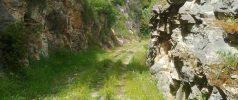
A few days ago, in the middle of the Pelion Peninsula, in an olive grove on the steep slope of the Centaur Mountains, I found the tracks of a forgotten narrow-gauge railway. In any case, it seemed to be forgotten. The grasses grew between the rails, the trees and bushes bent over the line of the absent carriages, and the surface on which the wheels usually roll did not shine in the sun – deep red rust is always a sign of oblivion.
READ MORE
theme of persistent wandering
There is one more widespread and intensely engaging theme in the music of Villagers of Ioannina City, which could be called the “theme of persistent wandering”. A theme independent of, but often related to, dance, both sometimes appear in the same pieces. Because for VIC, dancing is also a kind of wandering. Wandering, journey, road is omnipresent and inevitable for the Villagers. So inevitable that in one of the tracks (Part V) there is even a metronome at the beginning. Villagers’ heroes go somewhere in almost every piece, they come from somewhere, they move through space and time, even at the speed of light, often in a circle, because everything changes cyclically. However, someone who follows only the lyrics of the VIC songs will not immediately understand that these are songs of the road. The persistent wandering manifests itself primarily in the purely sonic layer. The music of the Villagers follows the rhythm of the road.
Although at first glance VIC is a metal band, there are actually no fast numbers that are so popular in heavy metal, with screamed lyrics for racing. Musically, it is a moderate hike rather than a fast run. It is not only about the beat, the speed of the snare drum and cymbal strikes, but also the phrasing and the sequences of moderate chords illustrate this movement. Even when the beginning takes the form of a prelude, an overture, i.e. a musically static form, the rhythm immediately appears and we are on our way. Of course, this road often leads… through the mountains.
The number of times mountains appear in the works of the band from Ioannina really amazes me. The heroes of the VIC either came from the mountains, or they go to the mountains, or they call to go to the mountains, both in songs with a certain social flair (Zvara) and in those cosmic-mythological (Age of Aquarius, Father Sun). However, these are not any specific mountains, there are no names of peaks or mountain ranges in the VIC songs. In this sense, it is not the work of “mountain lovers”. Rather, the mountains are the basic and obvious (or perhaps the most important) area of human activity. And it’s hardly surprising since 82 percent of Greece’s land is mountains. You can see them from anywhere, even from as flat as Larrisa, and around many peaks, the sea of summits stretches to the horizon in all possible directions. The gods of ancient Greece lived in the mountains (identification with antiquity is very easy here, although unpopular). The revolution of the beginning of the 19th century came out of the mountains, and the civil war in the 1940s was also largely fought in the mountains. But it’s not only about history. The cultural landscape of the present day is also a mountain landscape. Many Greek cities are situated on slopes and the streets are so steep there that they often turn into stairs. Ancient temples, all the ancient Greek theaters, fortresses and castles from different historical periods (there are plenty of them in Greece) – all located in the mountains. If running in the mountains had not been invented in America and France, it would certainly have happened in Greece – this country is made for mountain activities. Greece is not beaches, Greece is mountains!
Greek mountains close to Delphi
Lost Trail
On Forgotten Paths on Olympus

This competition actually started on Friday, when it rained in Litochoro. Or maybe even a few days earlier, when on some weather map I saw that typhoon Janus was approaching Greece. But a typhoon (tornado, etc.) in the Mediterranean? There is hardly any wind here.
READ MORE
finish line in Tsepelovo
The ascent ended four kilometers before the finish line. Before that, we had finally managed to escape from Mega Lakkos, a great gorge with a view of a dry river below. Short flat stretch, last feeding point, and I was on the downhill. I knew it would be like that, I knew this fragment from training sessions. Gently at first, and then breakneck, steep Tsepelovo Stairs, full of moving stones and serpentine bends, we ran up the hill at the very beginning. I regained some strength and began to accelerate. I could see Tsepelovo below, hear the sounds of the finish line.
The last few meters of the Zagori Marathon are probably one of the most beautiful ending sections in Greece. Tsepelowo welcomes us with tropical greenery and a few abandoned buildings, then there is a church and the main square of the village with huge plane trees, many taverns and cafes, and finally the main street, up to the abandoned school, where there is the finish line. Along the way, cheers, applause, music, hundreds of people cheering in taverns and on the street so that you almost have to squeeze through the crowd. The whole village is alive during these few days only with these competitions, the atmosphere is really amazing. I was the 27th competitor at the finish line after 6 hours and 25 minutes. On the one hand, I’d rather finish under six hours, on the other hand it’s a pity that something so unusual ended so quickly.
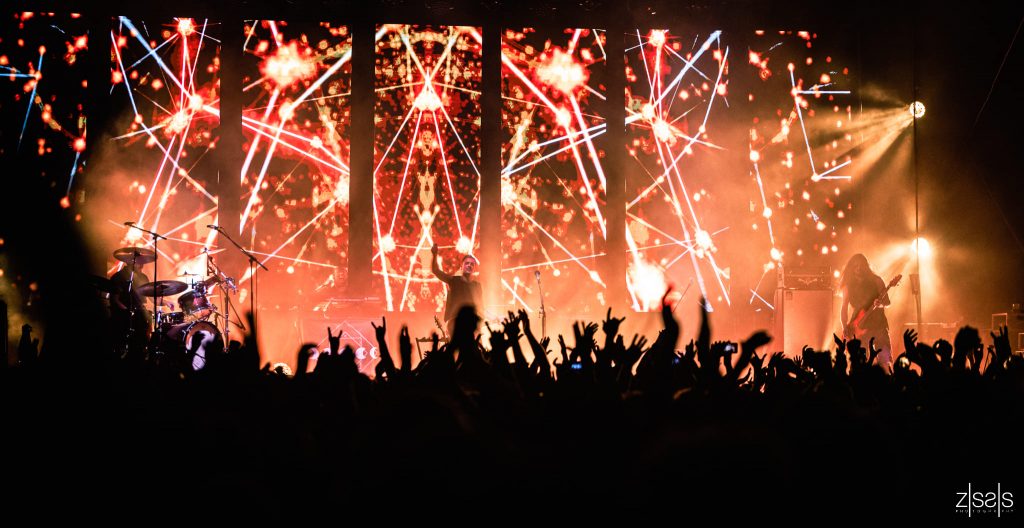
Villager's cosmic music
The Age of Aquarius, dancing, hiking through the mountains, Zagori Running – we are still on Earth. But maybe it’s not enough. After all, the music of Villagers of Ioannina City has an obvious cosmic aspect. And as in the case of other motifs, it also manifests itself in the purely sonic layer, not only verbal. There are two instrumental only tracks on the Age of Aquarius album: “Arrival” and “Sparkle out of Black Hole”. Arrival is an evidently depicted – using musical means – a scene of the landing of a spacecraft. Despite the limited instrumentation (again a solo on the bagpipes), the scene is very suggestive, which Vangelis himself, a true grandmaster of “cosmic music”, would certainly not be ashamed of. The dramaturgy of the album – Arrival appears right after Dance of Night, full of expectations and rich in content – suggests that it is about the arrival of the title Aquarius. He would therefore be a combination of a demiurge, the new hope of humanity and a traveler traversing the vastness of space. The vastness in the literal sense, because the VIC shows an amazing knowledge of the latest theories of quantum physics and cosmology, likes to use terms such as “at the speed of light”, “bending of time and space” or “spark out of black hole”.
Especially the latter term seems very interesting. It is scientifically based on the theorem of the great physicist Stephen Hawking, who already in 1974 suggested that black holes are not so black, in fact because of quantum effects they must emit a kind of radiation, as a result they lose energy and mass very slowly and will eventually evaporate completely (in the case of small black holes it will happen fairly quickly, with a spectacular explosion at the end). The term “sparkle out of black hole” would therefore be scientifically meaningful, but above all extremely rich in associations. In the song “Cosmic Soul” it appears as a synonym for another world, the place where the cosmic soul is born, and also a metaphor for the ultimate overcoming of one’s own weaknesses, discovering everybody inner cosmic soul, spiritual love and salvation. No wonder then that in another piece (Nova from Riza album) there is an amazing image of a bright light (halo) surrounding all living creatures. After all, we have the Age of Aquarius, the world will be changed, salvation will cover the entire cosmos (even demons – this is a statement from another VIC song), justice and universal happiness will reign. This is how the hippie idea of the Age of Aquarius finds its final definition.

Supermassive black hole in the center of Messier 87 galaxy some 55 million light-years from Earth. It has a mass 6.5 billion times that of the Sun. We can't see the black hole itself, the hot disk of material that encircles it shines bright. Photo: Event Horizon Telescope collaboration et al., 2019.
sparkle out of black hole
If “sparkle out of black hole” is her most perfect metaphor, we can even hear it. Sparkle out of Black Hole is the last track on the Age of Aquarius album. Cosmic sounds again, again the illustrative aspect of VIC’s music and again an extremely suggestive image. “Electronic music” achieved almost exclusively by guitar riffs. Full of space, sharp edges and crazy expression. We hear like a quantum of light break away from the event horizon, lose its virtual partner and escape screaming into other space. Could there be anything more amazing? It turns out that the impossible exists.
find out more
Official Villagers of Ioannina City website
All details about Zagori Mountain Running competition you can find here
You can also check the other Running Competition in Greece in my short guide
Larisa – Delphi – Karpenisi – Chania, September/October 2022


